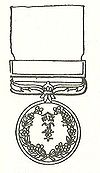Medals of Honor (Japan)
Medals of Honor (褒章 hōshō?) are a medal by the Government of Japan. They are awarded to individuals who have done meritorious deeds and also to those who have achieved excellence in their field of work. The Medals of Honor were established on December 7, 1881, and were first awarded the following year. Several expansions and amendments have been made since then. The medal design for all six types are the same, bearing the stylized characters 褒章 on a gilt central disc surrounded by a silver ring of cherry blossoms on the obverse; only the colors of the ribbon differ.
If for some reason an individual were to receive a second medal of the same ribbon colour, then a second medal is not issued but rather a new bar is added to their current medal. The Medals of Honor are awarded twice each year, on April 29 (the birthday of the Shōwa Emperor) and November 3 (the birthday of the Meiji Emperor).
First awarded in 1882. Awarded to individuals who have risked their own lives to save the lives of others.
First awarded in 1882. Originally awarded "to children, grandchildren, wives and servants for remarkable acts of piety; and to individuals who, through their diligence and perseverance while engaging in their professional activities, became public role models".
Changed social values after World War II had resulted in the conferment of this medal being suspended after 1950; since 1955 it has been replaced to some extent by the revived Medal with Yellow Ribbon (see below). However, in 2003 the Medal with Green Ribbon was revived as an award to morally remarkable individuals who have actively taken part in serving society.
First awarded in 1887 (later abolished); revived in 1955. Awarded to individuals who, through their diligence and perseverance while engaging in their professional activities, became public role models.
First awarded in 1955. Awarded to individuals who have contributed to academic and artistic developments, improvements and accomplishments.
...
Wikipedia

